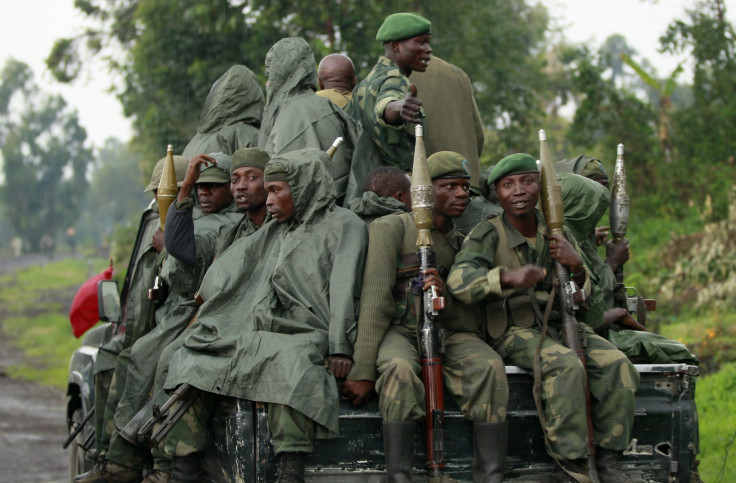One Down, Dozens To Go: For UN Peacekeepers In DR Congo, M23 Was Only The Beginning

The rebel group M23 no longer tops the list of priorities for the United Nations peacekeeping force in the Democratic Republic of the Congo, but dozens of other militant organizations will keep the international troops as busy as ever.
The DR Congo is home to a kaleidoscope of armed groups that regularly commit human rights abuses against civilians in the vast, poverty-stricken country of 66 million. Mineral wealth -- the land is rich in valuable elements like tantalum, gold and cobalt -- helps fuel the militants' activities, and the national government is too weak to extend its influence far beyond the far-west capital city of Kinshasa.
Though the DR Congo remains one of the most unstable countries on earth, the threat posed by M23 seems to have faded. M23 seized the eastern town of Goma in November, embarrassing the 18,000-strong U.N. peacekeeper outfit, called Monusco, that maintained a base there. The militants were ousted after 10 days, but they didn't go far and continued to pose a threat to the region. Monusco has since been strengthened by a so-called "Intervention Brigade" -- about 3,000 new troops with a robust mandate for combat -- and was finally able to push M23 from its stronghold near Goma this September.
M23 is now in talks with the Congolese government in Uganda's capital city of Kampala, though the process has stalled repeatedly: An agreement is reportedly being held up by concerns about amnesty for certain militants and the terms of a possible reabsorption into the Congolese army. As those discussions drag on, Monusco's Intervention Brigade is putting two other militant groups in its sights: the Democratic Forces for the Liberation in Rwanda, known by its French acronym, FDLR, and the Allied Democratic Forces, or ADF, an Islamist organization.
"If we do not manage by one way or another to neutralize, disarm, demobilize those groups, we are not very hopeful [for sustainable peace]," said Ray Torres, head of Monusco in the region, according to Reuters.
The FDLR is composed mainly of ethnic Hutu militants opposed to Tutsi rule in neighboring Rwanda; both the Rwandan and Congolese militaries are battling the group. The ADF is characterized as an Islamist group with Ugandan roots and has been behind sporadic attacks that have displaced tens of thousands over the past two decades.
But, as is the case with most armed groups in the DR Congo and surrounding region, these militant movements are not always easy to identify. They operate in lawless regions where security is scarce and governance is lacking, giving them the opportunity to become community leaders and drivers of underground commerce. This, in turn, often results in a high degree of assimilation -- and a high degree of adaptability to changing regional politics. The ADF, for instance, is not composed entirely of Islamists and has seen many of its former fighters become high-ranking members of Congolese communities. In the case of the FDLR, a growing number of Congolese fighters have been absorbed into the group, and Rwanda suspects Congolese authorities of backing the militants in secret.
Even M23, which consists mainly of ethnic Tutsi Congolese nationals, has been a shifty organization. Though it first coalesced in 2012, it has older roots in an insurgency called the National Congress for the Defense of the People, which cropped up in 2004. Those fighters were absorbed into the Congolese army in a March 23, 2009, peace agreement -- hence the name M23. Complaints that the deal hasn't been upheld led to the group's 2012 reincarnation.
Overshadowing all of these complications is a recent history full of devastating conflict, beginning with the Rwandan genocide that pitted extremist Hutus against moderates and Tutsis and killed 800,000 people in 1994, followed by two massive wars between 1996 and 2003 that pitted Rwanda and Uganda against the DR Congo and allies, killing millions.
Against this backdrop of old bloodshed, ongoing insecurity and ever-shifting alliances, Monusco's shift in focus from M23 to the FDLR and ADF is only one of many steps the DR Congo needs to take in order to achieve stability. A longer-term plan for political development and civil society involvement is clearly needed. There have been many attempts to formulate one, like the framework signed in February by African leaders in Ethiopia, called the Peace, Security and Cooperation Framework for the Democratic Republic of the Congo and the Region; or the report developed at Kinshasa gathering this May called the Consultative Conference on Peace Agreements and Conflict Minerals in the DRC.
But these efforts have yet to bring any measure of stability to the DR Congo's lawless zones, leaving Monusco to go after militant groups as a stopgap measure until broad-based, sustainable development can begin to kick in.
© Copyright IBTimes 2025. All rights reserved.






















